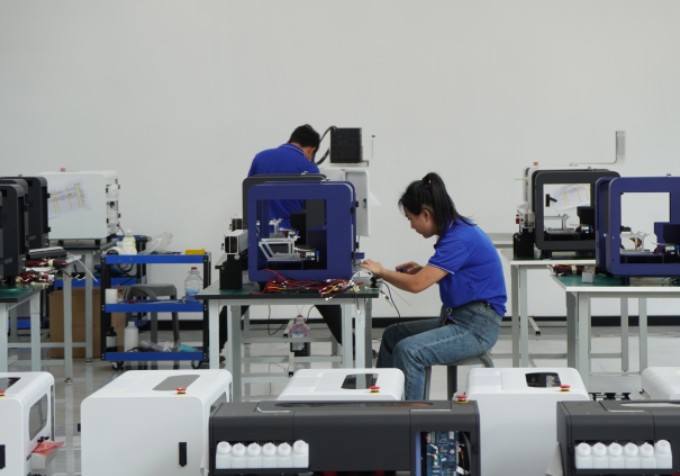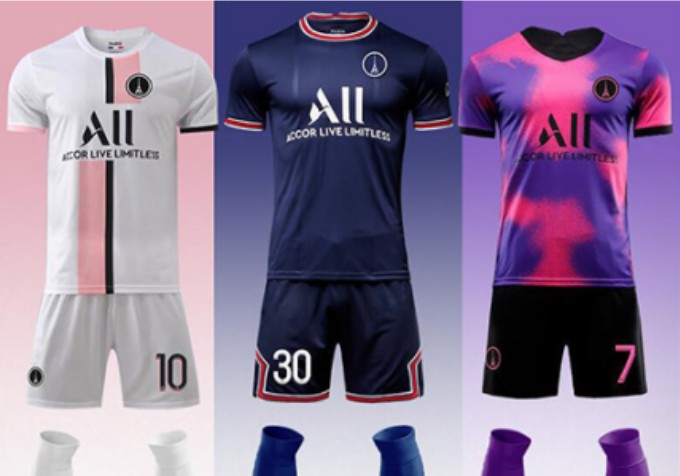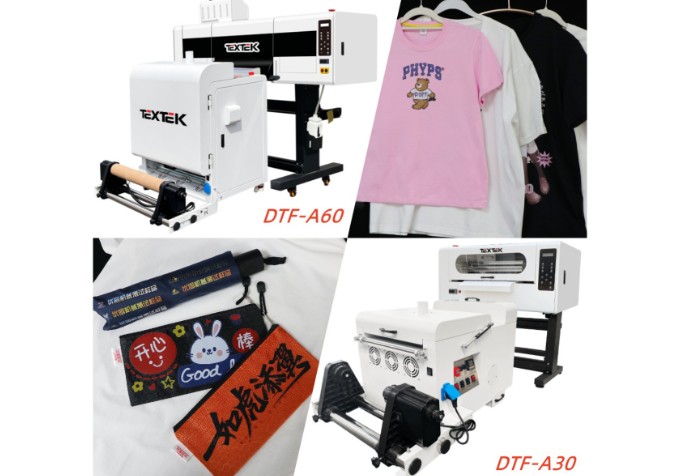DTF provides an excellent option for textile printing businesses, offering high quality and flexibility in garment design. The technology allows complex designs and fine details to be printed on a wide variety of fabrics, making it ideal for professional printing needs. DTF transfer iron-on images are also very resistant and durable, fulfilling the high demands of textile printing.
 What is DTF printing?
What is DTF printing?
DTF printing, often referred to as direct to film printing, is a process that comprises printing your design directly on a film before transferring it to various fabric types, including cotton, polyester, synthetic, or silk, regardless of their color. This method facilitates the use of white ink, so it can successfully accommodate designs that require it. DTF printing can produce full-size prints of the highest caliber, featuring vibrant hues and an unusually soft texture. DTF (Direct-To-Film) printing process is a type of transfer printing.
Transfer printing in textiles involves heating different fibers in the fabric or garment to high temperatures in order to transfer dyes from a colorful design on paper to the fibers. The fibers absorb the pigments when they evaporate. In this printing process, the transfer of a pre-printed design from paper to fabric occurs under carefully controlled temperature, time, and pressure. France granted the first transfer printing patent in 1958, and in 1968, heat transfer printing became commercially available. Manufacturers can use transfer printing for both woven and knit materials, but they most frequently employ it on knitwear. This technique allows printing of T-shirts, sweaters, and other fully or partially completed clothing, either continuously or in batches.
Direct-to-Film (DTF) printing technology allows printing on various surfaces, including:
Fabrics: DTF is commonly used for printing on fabrics such as cotton, polyester, blends, and even nylon. It can be used to print on t-shirts, hoodies, sweatshirts, socks, and other textile products.
Garments and Apparel: DTF technology is suitable for printing on various types of garments, including shirts, pants, dresses, jackets, and more. It offers flexibility in terms of design and customization options.
Accessories: DTF can be applied to print on accessories like bags, hats, caps, shoes, and other fashion accessories made of suitable materials.
Home Textiles: DTF printing is also utilized for printing on home textiles such as curtains, pillowcases, bed sheets, towels, and upholstery fabrics.
Promotional Items: DTF technology can be used to print on promotional items like tote bags, banners, flags, and other promotional materials made of compatible materials.
Decorative Items: DTF allows printing on decorative items such as cushions, wall hangings, tapestries, and other fabric-based decorative pieces.
Sports and teamwear: DTF is commonly used in the sports industry to print on jerseys, uniforms, teamwear, and sports-related textiles.

It's important to note that DTF technology is typically best suited for surfaces made of fabric or textiles. However, the specific materials that can be printed using DTF may vary based on the capabilities and compatibility of the DTF printer and the DTF transfer film being used. It is recommended to consult the manufacturer's guidelines and test compatibility before attempting to print on a specific surface or material.
What fabrics can DTF printers print on?
There are many compatible fabrics including cotton, nylon, leather, polyester, denim, and light and dark fabrics. This is different from DTG technology which only works on cotton fabrics. This therefore means that the printer can work on wider substrates, making it the most versatile digital printer on the market.
While direct-to-garment printing works best on 100% cotton, DTF is suitable for many different garment materials: cotton, nylon, denim, treated leather, polyester.
Polyester
The polyester print is bright and vivid. This synthetic fabric has a wide range of uses including sportswear, casual wear, swimwear, outerwear, including linings. . Polyester fabric has the characteristics of high elastic recovery ability. Therefore, it is highly durable and wrinkle-resistant. In addition, polyester has excellent heat resistance and light resistance. Acids and alkalis have no effect on polyester, making it immune to mold and insects. Sublimation printing can also be applied to polyester fabrics, but is limited by light colors. It's not as practical as DTF printing which can print all colors. They are also easy to clean. In addition, DTF printing does not require pre-processing like DTG.
Cotton
Cotton fabrics are more comfortable than polyester fabrics. Therefore, they are a popular choice for clothing and home furnishings such as decorative linings, bedding, children's clothing and different professional items.
Silk
Silk is a typical protein fiber that develops from the shell of mysterious crawling larvae. Silk is a naturally strong fiber because it has excellent tensile strength and can withstand a lot of pressure. Additionally, silk texture is known for its sparkling appearance due to its three-sided crystalline fiber structure.
Leather
DTF printing also works on leather and PU leather! The effect is very good, many people are amazed. It's durable and comes in gorgeous colors. Leather is used for a variety of purposes, including making bags, belts, clothing, and shoes.
Nylon
Nylon fabric cannot be dyed or printed in high temperature environments, so direct jet printing is often used for printing, and acid dyes are also used. The difficulty with acid dyes is that the color is unstable and the color fastness is poor after printing. These problems have been around for a long time.
Denim
Denim is a thicker twill cotton fabric with a yarn-dyed surface. Originally, denim was only available in blue and was used as a canvas. But with the development of technology, denim is used in different colors, such as jeans, dresses, coats, bags, etc. The feel of denim is different. Some are soft and some are hard. Some are rough, some are delicate. Denim produced from combed cotton yarn has a smooth surface, vivid lines and refreshing touch.

DTF is suitable for synthetic materials such as cotton or silk, polyester or rayon. Their fabrics come in both light and dark colors. They look great. Prints stretch without cracking. The DTF process outperforms all other printing technologies in fabric selection.
TEXTEK DTF printers (direct to film printers) work on all fabrics and are perfect for custom garment printing. You can expand your inventory by applying your designs to various items via DTF. With the advancement of DTF technology, it is undeniable that DTF is taking the printing industry by storm. It is quickly becoming one of the most popular technologies for textile printing compared to traditional printing methods.
TEXTEK's business covers many countries around the world, including emerging markets and mature markets. We have a complete sales system and are committed to using our professional knowledge and first-class service to help customers improve their digital printing business.
.jpg)



.jpg)
